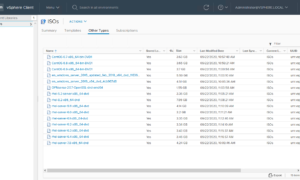If your looking at different servers to buy for your next virtualization project make sure you check the memory that they come with. New servers utilize DDR3 RAM which comes in several different flavors, there are registered or unbuffered, and single rank, dual rank, or quad ranked…. basically there are a bunch of options.
I’m writing this because most people are just concerned with the number of GB in a server… well your right that makes a difference, but if you don’t pay attention and get UDIMMs you might have to throw them all away and start over with RIMMs at some point.
If you read the small print on the HP quickspec page (and this is true for all Intel 5500 or 5600 series servers as far as I know) you will see that there is a severe capacity limitation with UDIMMs.
Maximum (RDIMM) 192GB (12 x 16GB) for Registered Memory configurationsMaximum (UDIMM) 48GB (12 x 4GB) for Unbuffered Memory configurations
In a DL380 or ML350 G6/G7 server there are 18 ram slots, with RIMMs you can only populate 12 of those slots, and the maximum dimm size is 4GB…. hence the 48GB limit.
This isn’t a huge deal if you’re loading windows or linux on the box and it is a standalone server, BUT if your loading VMware or Xenserver and are going to run a pretty decent amount of VM’s that is a problem.
So my recommendation is that if you’re buying new hardware and going to use it for virtualization, make sure your getting RDIMMs and not UDIMMs.
![]()



Hello,
You mean “In a DL380 or ML350 G6/G7 server there are 18 ram slots, with **UDIMMs** you can only populate 12”
Cheers.
Hi
Can you explain why is it not a good idea to use UDIMM for setting up Xen Servers?
I’m about to set up a Xen Server yet the hardware that I found only supports UDIMM memory.
Thanks a lot!
Thanks Justin.
Do you ahve any experience on UDIMM on Windows 2008 VMs?
What type of experience do you mean ? UDIMM and RDIMM shouldn’t make any difference to a VM
how do i tell the difference between UDIMM and RDIMM?
i have two types, one with metal caging (can’t think of a better word) the other is the normal. none are written what they are..
You will need to go by the part number on the stick… best way would be to google it or compare it to the manufacturers spec page
Patrick,
The memory works the same, but motherboards can’t access as much unbuffered memory as they can with registered “fully buffered” memory.
There are other differences. A single UDIMM per channel is one tick faster, but Justin is right that you can only put 2 UDIMMs per channel, and they aren’t as big (max of 4 GB/DIMM in the DL380 G7 QuickSpec). For 2 or more DIMMs/channel you will get better performance from RDIMMs — operational memory speed and interleaving favor RDIMMs. Plus they come in 48 GB parts (at $3000 list each).
A good read is the ‘DDR3 for Dummies’ ebook available from HP for free:
http://hpddr3.hardingmarketing.com/regForm.html
Certainly explained a few things for me!
thanks for the info Steve!
What’s different bewteen Rdimm or Udimm and SRAM/DRAM? Are thoes equal to each other? ie. Rdimmm = SRAM and Udimm = DRAM?
Please correct my concept, thanks!
SRAM(Static Random Assessable Memory)-where the word static indicates that it, does not need to be periodically refreshed, as SRAM uses bistable latching circuitry (i.e., flip-flops) to store each bit. Each bit is stored as a voltage.Each memory cell requires six transistors,thus giving chip low density but high speed.However, SRAM is still volatile in the (conventional) sense that data is lost when powered down.
Disadvantages are more expensive and also consumes more power than DRAM.
In high speed processors (such as Pentium), SRAM is known as cache memory and is included on the processor chip.However high-speed cache memory is also included external to the processor to improve total performance.
DRAM(Dynamic Random Assessable Memory)- Its advantage over SRAM is its structural simplicity: only one transistor (MOSFET gates) and a capacitor (to store a bit as a charge) are required per bit, compared to six transistors in SRAM. This allows DRAM to reach very high density.Also it consumes less power and is even cheaper than SRAM (except when the system size is less than 8 K) .
But the disadvantage is that since it stores bit information as charge which leaks;therfore information needs to be read and written again every few milliseconds.This is known as refreshing the memory and it requires extra circuitry,adding to the cost of system.
Read more: http://wiki.answers.com/Q/What_are_the_differences_between_SRAM_and_DRAM#ixzz1kF1IJsw9
You should just buy a Dell server
lol why is that ?
@ Justin: RDIMMs* & What Ameen said. Also…”(Static/Dynamic) Random ACCESS Memory” (NOT Assessable -_- ) SRAM NOT to be confused with SDRAM (Synchronous Dynamic Random Access Memory)
@ Robert: You should just build a damn server -_-
@Xomsabre: I copied that information directly from the wikipedia article. If its wrong its because of them.
I disagree with building a server… there is something to be said to selling a product that is uniform, it makes getting replacement parts as well as support much easier….. You get what you pay for i guess.
What is the meaning? (UDIMMS) / (RDIMMS)